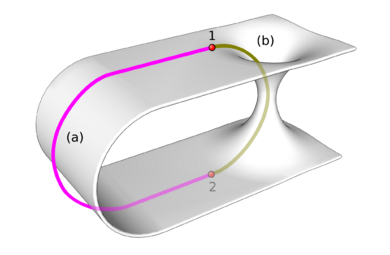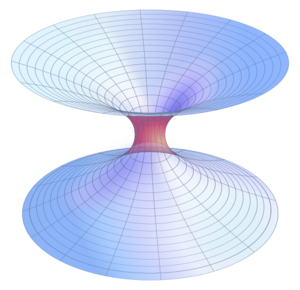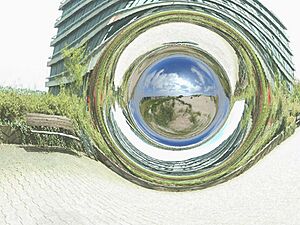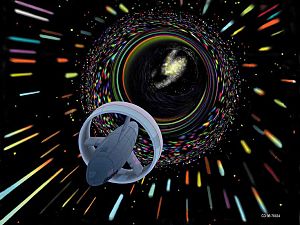Wormhole facts for kids
A wormhole is a theoretical tunnel through spacetime that could create a shortcut for long journeys across the universe. Imagine you could connect two very distant places with a special passage. This passage is what scientists call a wormhole.
Wormholes are an idea that comes from Albert Einstein's theory of general relativity. However, no one has ever found a real wormhole, so we don't know if they actually exist. They remain a fascinating topic for scientists and in science fiction.
Contents
Where Did the Name "Wormhole" Come From?
The idea of a wormhole has been around for a while. In 1928, a scientist named Hermann Weyl had an idea about "one-dimensional tubes" connecting different parts of space.
However, the name "wormhole" was created later. In 1957, an American physicist named John Archibald Wheeler came up with the term. He thought of the universe as being like the skin of an apple. A worm chewing a path from one side of the apple to the other through the middle, instead of crawling all the way around the outside, is taking a shortcut. A wormhole in space would be a similar kind of shortcut.
Are All Wormholes the Same?
Scientists have thought about different kinds of wormholes. Not all of them would be useful for travel.
Einstein-Rosen Bridges
The first type of wormhole that scientists studied is called an Einstein-Rosen bridge. It was named after Albert Einstein and Nathan Rosen, who wrote about it in 1935. This type of wormhole is also known as a Schwarzschild wormhole.
These wormholes are connected to black holes. The problem is that they are very unstable. Scientists believe they would collapse so quickly that not even a beam of light would have time to travel through it. So, you couldn't use one to go anywhere.
Traversable Wormholes
A traversable wormhole is a wormhole that you could, in theory, travel through. It would be stable enough to stay open long enough for something to pass from one end to the other.
So, how could a wormhole stay open? Some physicists, like Kip Thorne, believe it would need a special kind of material called exotic matter. This isn't like any matter we know. It would have to have strange properties, like negative energy, to push the walls of the wormhole open and stop it from collapsing. We have never found any exotic matter, so this is still just an idea.
Could Wormholes Allow Faster-Than-Light Travel?
According to Einstein's theories, nothing can travel faster than the speed of light through space. So how could a wormhole help you get somewhere faster?
A wormhole doesn't break the speed of light. Instead, it creates a shortcut. Imagine you have a large sheet of paper, and you want to get from a point on one side to a point on the other. The longest way is to travel across the surface of the paper. But if you could bend the paper and poke a hole through it, you could create a much shorter path.
A wormhole would work in a similar way by bending spacetime. The distance through the wormhole could be much shorter than the distance outside the wormhole. So, even though you would be traveling slower than light inside the tunnel, you could arrive at your destination faster than a beam of light traveling the long way around.
What About Time Travel?
If stable wormholes are possible, some scientists think they could also be used as time machines. Here's how it might work:
Imagine you have a wormhole with two ends, or "mouths." You leave one mouth here on Earth, and you put the other mouth on a super-fast spaceship. The spaceship travels far away at nearly the speed of light and then comes back.
Because of an effect called time dilation, time would pass more slowly for the moving wormhole mouth than for the one that stayed on Earth. When the spaceship returns, the moving mouth would be "younger" than the stationary one.
This would create a time tunnel. If you entered the "younger" mouth, you might exit the "older" mouth in the past. However, there's a catch. You could only travel back to the time when the wormhole was first created. You couldn't use it to visit the dinosaurs!
Could Wormholes Lead to Other Universes?
Time travel creates tricky questions called paradoxes. For example, what if you went back in time and prevented your parents from meeting?
Some scientists think that wormholes might avoid these paradoxes by connecting to parallel universes. According to this idea, if you traveled back in time through a wormhole, you wouldn't arrive in your own past. Instead, you would arrive in the past of a different, parallel universe.
This would mean you couldn't change your own history, but you could visit a new one. This idea of traveling between universes is called interuniversal travel, and it's a popular theme in many stories.
Wormholes in Movies and Books
Because they are such a cool idea, wormholes are very popular in science fiction. They are a perfect way for writers and filmmakers to let characters travel huge distances across space in a short amount of time.
In stories, wormholes are often called "stargates," "jump gates," or "warp portals." They allow spaceships to travel between stars or even galaxies quickly, making exciting adventures possible. Sometimes, they are also used as a way for characters to travel through time. Many popular movies, TV shows, and books use the idea of wormholes to explore the universe and beyond.
See also
 In Spanish: Agujero de gusano para niños
In Spanish: Agujero de gusano para niños
- Alcubierre drive
- Gödel metric
- Krasnikov tube
- Non-orientable wormhole
- Novikov self-consistency principle
- Polchinski's paradox
- Retrocausality
- Ring singularity
- Roman ring





